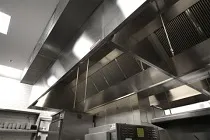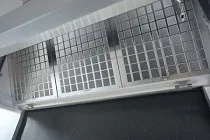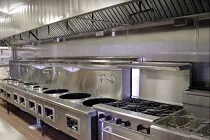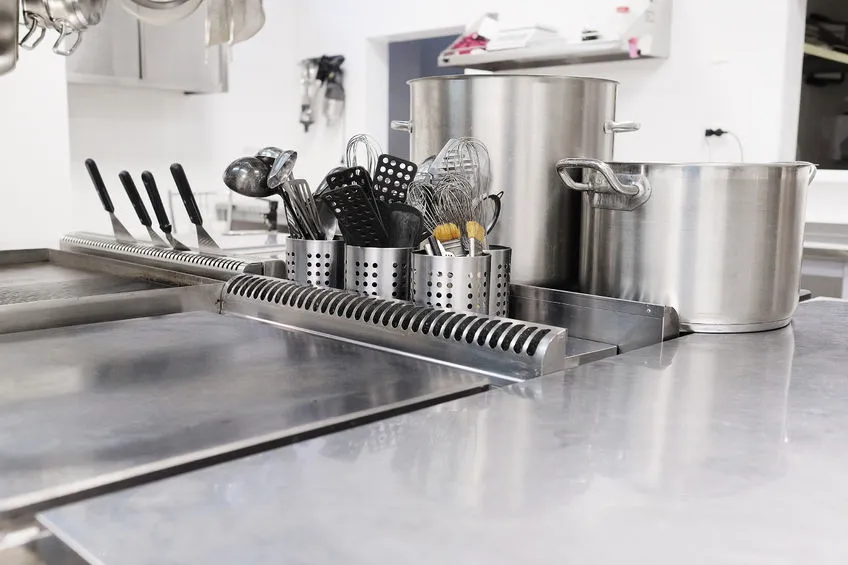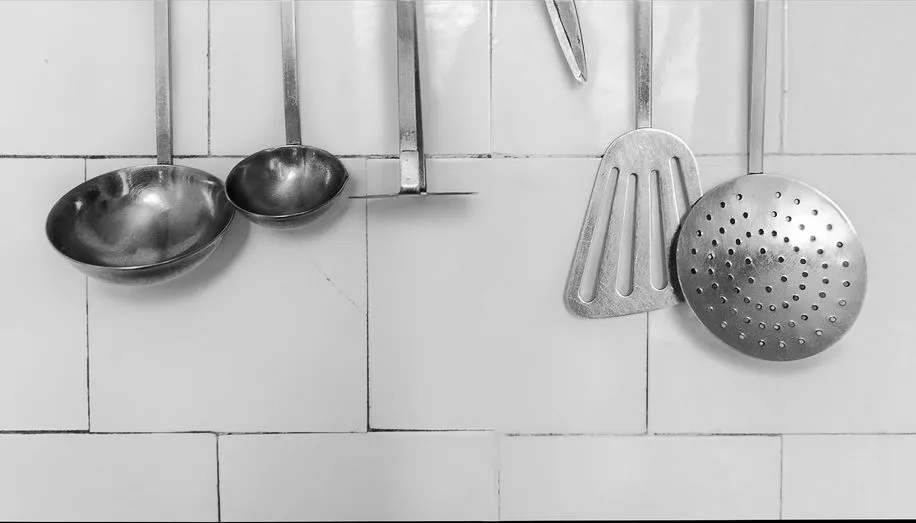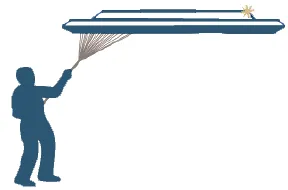
Denver, CO 80222
Commercial Kitchen Equipment FAQ | Denver, CO
Do you guarantee your work?
Yes! We guarantee that our service, maintenance, and cleaning technicians will perform a stellar job. Call now to get a free estimate for the type of work you have in mind.
What areas do you service?
We proudly service the areas of Denver, Colorado. Call to find out if you reside in our service area.
What services do you offer?
We clean, repair, and maintain all the components that make up a commercial kitchen, from the appliances and exhaust systems to the fan on the roof. We offer pressure washing for the interior and exterior of your business, and we specialize in fire suppression systems as well.
Contact us for all your commercial kitchen needs. We can keep your business clean and well-maintained long into the future.What is a restaurant hood?
A restaurant hood is a device that is affixed above your cooking appliances to catch all the hot air, grease, and other contaminants that are produced during the cooking process. The exhaust hoods keep the air in the kitchen clean, smoke from building up, and the food quality pure for rave customer reviews.
How do you deep clean a commercial kitchen?
By calling on the professionals to do the job. When we perform a deep-clean of a commercial kitchen, we clean every surface, including your cooking prep areas, and all the walls, ceilings, and floors. We clean your appliances, using special degreasing agents and methods that are safe for equipment made of stainless steel. And we wipe down your walls and floors with a powerful restaurant-grade degreasing agent.
How do you install a hood fan?
Commercial kitchens have to abide by strict ventilation rules to ensure the air remains safe and breathable for staff and customers. Your ventilation system is intricate and involves the ventilation hoods that are located over your appliances, the accompanying grease ducts, and the fan on your roof. Installing a roof fan can be complicated and is best left to the professionals. If you get something wrong, not only could it prove to be expensive to fix, and lead to poor air quality, but you may also void the warranty on your equipment. Contact APS-Hoods instead. We can install your roof for a fair price and on your schedule anywhere in Denver, Colorado.
How Often Should I Have My Vent Hoods Cleaned?
The frequency of cleaning will depend on your daily cooking volume. Fast food and other high-volume restaurants will benefit from a deep clean every thirty days.
The average restaurant can get away with having the vent hoods cleaned every ninety days, but many can get away with a cleaning every six months.
Those are the cleaning requirements for vent hoods that are located directly over greasy appliances. For non-greasy appliances, a deep clean each year should suffice.
Why Can’t I Just Rely on My Employees to Clean My Vent Hoods?
Ventilation hoods work hard to remove impurities from the air and the food you prepare. If you don’t clean your vent hoods thoroughly, those impurities could find themselves kicked up into the air and your customers could taste something a little off in the meals they order.
Your staff isn’t trained in the ways of cleaning ventilation systems for commercial establishments. A team like the one we offer at APS-Hoods possesses the training, proper equipment, and time-tested techniques to keep your ventilation hoods clean for improved air cleanliness and food quality.
When I Hire Hood Builder to Clean My Kitchen, Will I Have to Shut My Business Down?
That depends on the type of restaurant you operate.
If you are a twenty-four-hour establishment, we may be able to work during slow times.
For most other businesses, we can conduct the necessary cleaning protocols during closing hours for minimal disruption to your business.
Do You Adhere to Any Standards When Performing Vent Hood Cleaning and Maintenance?
At APS-Hoods, we keep to the very highest industry standards when cleaning ventilation hoods and maintaining equipment for establishments of all types.
Restaurant cleaning requires powerful solutions that are safe enough to use on food.
We have those solutions and the tools to apply them so that your air remains pure and your environment stays of the highest quality.
Proper vent hood cleaning and maintenance also keep your meal offerings tasting their best for superior customer satisfaction.
How Much Do You Charge for Vent Hood Cleaning Denver?
You can expect to pay between $135 and $180 per hour for commercial ventilation hood cleaning. Cleaning the exhaust fan could cost extra. Contact APS-Hoods to request a free estimate to get a better idea of what you can expect to pay for the cleaning you need.
Is Your Work Guaranteed?
Absolutely! We adhere to the strictest of cleaning standards and take great pride in our work. We guarantee that we can keep your vent hoods cleaned and maintained long into the future. Ask about a commercial ventilation hood cleaning schedule that works for you.
How Long Does It Take to Clean the Average Commercial Kitchen?
The time it takes to clean a commercial kitchen depends on the size of your kitchen, the number of appliances, and your overall kitchen layout. Generally speaking, thorough cleaning of all ventilation equipment can take between one and three days to minimize disruptions to your business.
Are You Licensed and Insured?
Yes, each of our commercial equipment cleaning and maintenance professionals is fully licensed and insured to work in Denver, Colorado.
What Other Services Can You Offer?
If it exists in your commercial kitchen, we can clean and maintain it. We specialize in exhaust system cleaning and ventilation hood cleaning, as well as equipment installation and maintenance service. We can also pressure wash and steam clean your many surfaces and provide you with top-to-bottom kitchen cleaning services the health inspector is sure to love. We are also known for our fire suppression system installations, service, and repair, and the fabrication and installation of all exhaust system components, including vent fans, heating, air conditioning, ventilation ducts, and vents.How much does it cost to put in a hood system?
You could pay anywhere from around $950 to $1200 per linear foot to have a commercial hood system installed. Most commercial hoods tend to run around ten to fourteen feet in length. The fees you pay will depend on the size of your hood and brand of the vent hood system.
How do you clean a commercial kitchen hood system?
When we go about cleaning a commercial kitchen hood system, we take every precaution to ensure the units are cleaned top-to-bottom. First, we cover all nearby appliances and equipment to ensure they stay protected, as commercial kitchen hood system cleaning can be a messy job. Next, we remove the grease receptacles on either side of the unit before soaking the filters in a degreasing agent. We then attack the grease that may be caked-onto the interior and exterior of the ventilation hood. We use powerful degreasers that are safe to use around food along with heavy-duty rags that won’t damage your stainless steel. We check the fan for proper operation, making any repairs if needed, and then we put the hood system back together, testing its function as well. We leave your ventilation system gleaming and sanitized in preparation for the next shift.
Do you need to be certified to clean kitchen hoods?
The adequate cleaning of commercial kitchen ventilation hoods can be an intricate process. An untrained person may leave behind grease and grime, which can cause a fire hazard, as well as raise a red flag with the health inspector. Certified vent hood cleaning technicians, like the ones we employ at APS-Hoods, are trained in the ways of cleaning hood systems so that they remain fire and health code compliant for your peace of mind.
How do you clean commercial stove grates?
Commercial stove grates can have caked-on food and grease that can be tough to remove. Use a scraper to remove as much of the food waste as possible from the grates and burner assemblies. Continue the process until the buildup is completely gone. You can then use a degreaser to remove any residue left behind. For best results, soak the stove grates and burners in a soap and water solution. Doing so will soften or dissolve the grime so that it can be wiped away cleanly.
Are range hoods hardwired?
Not necessarily, though hard-wired range hoods are the preferred method approved by all building codes and the method used by all professional installers.
Are ductless range hoods effective?
We do not recommend ductless range hoods for the commercial kitchen environment. This is due to the fact that ductless hoods tend to recirculate the foul air back into the kitchen as opposed to venting the foul air outside. Not only can this lead to smoke and impurities find their way into the air your staff and customers breathe, but your kitchen could get awfully humid. For all commercial kitchens, we recommend a vented range hoods. Make sure you change the filters in your hoods every three to six months to keep them working as intended.
What is a commercial grease trap?
A commercial grease trap collects grease and prevents food, organic waste, and grease from entering the local septic system.
How much is a commercial grease trap?
The amount you pay for a grease trap will depend on the size of the unit, with smaller grease traps running between $250 and $1500. Call APS-Hoods to discuss your grease trap needs for a more accurate quote.
How do you clean a commercial grease trap?
You can clean a grease trap yourself, but it’s not recommended. The job can get extremely messy and requires approved disposal methods. You can’t just dump all the collected grease down the sink, after all. To clean the trap yourself, you will have to remove the lid. Take care to remove the lid slowly so that you don’t snap the gasket underneath. Scoop out all the grease and sludge and use a dedicated shop vac to remove all the excess grease left behind. Next, use a powerful degreasing agent to scrub the inside of the tank. You may have to scrap some of the residues with a metal scraper, taking care not to damage the inside of the tank itself. Once the grease trap is cleaned, it should be tested for proper function. The recommended route is to call APS-Hoods for complete grease tank cleaning. We can get your tank clean and dispose of your grease to keep your commercial kitchen code compliant.
How do you remove grease buildup from kitchen walls?
Your restaurant should keep on hand powerful degreasing agents that are safe to use around food. Make sure you scrub the walls nightly with a deep clean each month or every ninety days. With regular cleaning, you should be able to prevent heavy grease buildups on both the walls and floors.
How do you know when grease trap needs to be cleaned?
You should always schedule grease trap cleaning whenever your unit gets to be about a quarter full.
How do you clean a greasy cooker hood?
What do you do when your range hood has become a greasy mess? Wipe down the hood to remove the sludge as best you can. Thick paper towels work best along with an anti-grease dish soap mixed in a little warm water. Once you feel like the hood is relatively clean, finish the job with a vinegar and water solution to clean the leftover residue.
How does a commercial grease trap work?
A commercial kitchen can produce a lot of greasy water that otherwise might find its way into the sewer system. Without a grease trap catching all that goopy water, the septic system could clog, leading to stinky and expensive sewer backups. A grease trap prevents all that by funnelling the greasy water into the trap. Once inside, the trap allows the heated water to cool before separating the FOG (food, oil, and grease) from the water. The food waste floats to the top and the water flows downward unobstructed into the sewer system.
How often should grease traps be emptied?
We recommend having your grease traps cleaned at least once every three months. Commercial kitchens that cook at a higher volume might benefit from monthly cleaning instead.
Does a 3-compartment sink need a grease trap?
We recommend that you have a grease trap with all commercial kitchen operations, and especially ones big enough to require a three-compartment sink. Over a typical day, FOG can find its way into your septic system, leading to costly clogs. A grease trap will keep the sewers clean and you safe from backups.
How do you know when a grease trap is full?
You could wait until the grease trap overflows, but by then it would be too late. You should check your grease trap periodically to ensure it remains less than half-full at all times. In fact, you should be cleaning your grease trap the moment it becomes ¼ full to prevent problems.How do you hook up air ducts?
Yes, we can connect every component of your ventilation system, from the hoods to the fans. We can ensure your duct system is state-of-the-art and code compliant.
Can I install central air myself?
You can, but we don’t recommend it. Installing an HVAC system is highly sophisticated work that involves schematics that must be followed closely, and duct systems that must be correctly routed. We recommend calling the professionals to do the job, such as our ventilation system technicians at APS-Hoods.
How long does flex duct last?
Most metal ductwork can last for 50 years or more. The lifespan of flex ducting varies, depending on the brand and configuration.
Should ductwork be replaced after 20 years?
That would be the recommended route. Ducting tends to have a lifespan of around 20 to 25 years. To ensure proper air quality, you might want to think about complete duct replacement.
Why do commercial establishments use air ducts?
An air duct allows for the free flow of good air replacement. Your HVAC system uses ducts to deliver clean air and remove bad air to keep the air inside the building “conditioned” and pleasant for your staff and customers.
How often should air ducts be cleaned in restaurants?
Over time, your ducts can become a dusty, moldy mess. The National Air Duct Cleaners Association recommends that you have your ventilation ducts cleaned every three to five years.
What is the best method for air duct cleaning?
Our air duct cleaners use a range of tools to clean every inch of your air ducts, including vacuum devices and elongated dusters. Our methods are designed to get to those hard to reach places where dirt and mold like to hide. We guarantee that your system will be thoroughly cleaned for maximum health and safety.
What does duct cleaning include?
Our commercial kitchen cleaning technicians also clean various heating and cooling system components that exist as part of your HVAC system. Our cleaning protocols include the supply and return air ducts, registers, grilles, diffusers, heat exchangers, cooling coils, and condensation drain pans. Our technicians will also clean and repair fan motors, fan housing, and the outside of the HVAC system itself. If it works as part of your heating and cooling system, our technicians will ensure that it is clean and in excellent working order.
Is duct cleaning really necessary?
Yes. Over time, the air ducts that remove bad air and supply clean air can become contaminated. Dust can develop on the inner walls and, if moisture is added to the equation, mold and mildew can develop. If left to get worse, these contaminants can find themselves in the air your staff and customers breathe. Your staff and customers could get sick and the health inspector could give you negative marks. Avoid negative reviews and possible fines by scheduling consistent air duct cleaning Clean air ducts allow for more breathable air, keeping your staff and customers healthy and happy.
Can I clean air ducts myself?
It is possible to clean the air ducts yourself. You will want to ensure you are very careful with the areas that aren’t easily accessible. Our commercial cleaning technicians know how to access the inner workings of your air ducts to get them clean without causing damage. Also, unless you know how to repair the inner workings of your HVAC system, you may not know how to proceed if anything malfunctions. A cleaning crew well-versed in duct cleaning can keep your duct system clean and well-maintained for better value.
How do professionals clean air ducts?
Very carefully. We use specialized tools that get to those hard to reach nooks and crannies where dirt and mildew like to hide. We use specially formulated cleaning agents that are safe to use on commercial ducting and that work to remove harmful bacteria, fungus, and mold. And we look for any components of the ventilation system that are malfunctioning so they can be maintained or repaired on the spot.
How long does it take to get ducts cleaned?
Depending on the size of your restaurant, your commercial ductwork could take between two and four hours to complete.
What happens if you don't clean your air ducts?
If you don’t clean your air ducts, dust can get kicked into the air your customers and staff breathe. Airborne illnesses could infect your customers, leading to visits from the health department. Mold and mildew could grow, making your staff sick. All of these scenarios can be avoided with regular duct cleaning by certified commercial kitchen cleaning professionals.
What is the average price for duct cleaning?
You can expect to pay between $300 and $500 for duct cleaning. Your fees could be greater or lower, depending on the size of your kitchen layout and your location. Call APS-Hoods in Denver, Colorado to learn more.
Why do restaurants need air duct cleaning?
Duct cleaning keeps the air in your commercial establishment clean and healthy. Duct cleaning can also keep the quality of your food pure. Finally, health inspects love clean ducting, making air duct cleaning a necessity for restaurant owners who want to remain code compliant.
How do you know if your air ducts need cleaning?
We recommend scheduling an air duct cleaning if your vent covers show signs of visible dust and you haven’t switched out your air filter in months. Other signs include noises in the ductwork, signs of mold in or around your HVAC system, and airflow that is inconsistent from room to room.
Does negative pressure air duct cleaning work?
Negative pressure air duct cleaning is one of the most efficient ways of getting ductwork clean. The negative pressure kicks all the dust and dirt into the air, allowing for easy suction and disposal. Even with negative pressure, sometimes technicians have to use brushes and scrapers to get to those stubborn areas in hard to reach places.
Do you tip Air Duct Cleaners?
You are not required to tip your air duct cleaners. Although, if you feel that your cleaners did an excellent job, a tip would be an excellent way to show your gratitude.
Do you need a license to clean air ducts?
Some states do not require a license to clean air ducts, but many do. However, we always recommend having a professional clean your air ducts. Professionals have the necessary equipment, powerful cleaning agents, and time-tested methods for getting commercial ductwork clean enough for health code compliance. You could do the job yourself, but you’ll get a better outcome by letting the experts handle the dirty work.
Do you tip HVAC maintenance?
You are never required to tip for HVAC service. However, if you like the service you receive, a tip can be a good way of showing your gratitude.
What is the best way to clean air ducts?
The best way to clean air ducts is with the proper tools and equipment. For large-scale commercial operations, we may use a combination of negative air pressure systems along with feather dusters, scrapers, and specialized enzyme-rich chemicals that remove grease, dust, dirt, bacteria, mold, and mildew. In addition to cleaning the air ducts, a thorough job also includes checking all the components of the HVAC system to ensure they are working properly.
Is Duct Cleaning worth it?
Absolutely! The health inspector can enforce hefty fines if you don’t keep your air ducts clean. Plus, your air and food could become contaminated, leading to bad reviews and a place customers would prefer to avoid. Keep the health inspector at bay and your customers always coming back for more by keeping your air ducts clean.
Can Air Duct Cleaning cause damage?
You can avoid damage to your ducting by relying on experienced professionals to handle the job. We have elongated poles, ladders, and other equipment that let us get to those hard to reach places for maximum cleaning and zero damage.
How do you clean Commercial kitchen air duct vents?
The vents themselves can be removed for thorough cleaning. Wipe the air vents with a feather duster or paper towels and then clean with a commercial-grade degreasing agent. Make sure the air duct vents are completely dry before reinstalling to prevent mold and mildew. You should also ensure you are changing your air filters regularly to keep the air vents from gathering dust.
Does duct cleaning remove mold?
Yes! Mold is one of the dangers that can form when you leave your air ducts to get dirty over time. Air duct cleaning will keep mildew, mold, and harmful bacteria from forming in your ductwork, leading to a cleaner atmosphere and happier customers.
Will Duct Cleaning remove the smell?
If there is an odor coming from your ductwork due to the growth of mold or mildew or the formation of dust, cleaning your ductwork will purify the air and highlight the aroma of your meal offerings.
Is Commercial kitchen duct cleaning noisy?
Air duct cleaning can be noisy when reverse air pressure machines are used to suction impurities out of your ductwork. Professional cleaning technicians will always strive to clean your ductwork quickly and efficiently without too much disruption to your business.
How do you detect duct leaks?
One of the best ways to determine if you have leaky ducts is to check the airflow in each room. If one room has less airflow than the rest, a leak could be in progress.
If my ducts are leaking, how can they be fixed?
Call APS-Hoods. We have commercial equipment repair technicians who can repair your leaky ductwork and replace your system if needed. We fabricate the parts and install your system to perfection for cleaner air every time.
What is included in HVAC rough in?
HVAC rough-in includes the air handler, ductwork, register boxes, diffuser, t-stat wiring, bath exhaust fan housing, and kitchen vent ductwork.
How long does flexible ductwork last?
Flexible ductwork can last for twenty or more years. Check with your duct manufacturer for details.
Is flexible ductwork good?
Flexible ductwork can be ideal for some commercial kitchen layouts. Your HVAC installer can help you determine the best type of ductwork for your kitchen environment.
Does a commercial oven need a hood?
We only recommend a ventilation hood for ovens if your ovens produce a lot of grease and smoke. Vent hoods collect grease, smoke, and other contaminants to keep your kitchen environment clean.
How much does it cost to install a Commercial kitchen exhaust hood?
Installing a commercial exhaust hood can set you back as much as $950 to $1200 per linear foot. Contact Aps-Hoods for details.
How do you clean a kitchen exhaust system?
Make sure you power the system down before you do any cleaning. You will want to remove the grease traps from either side of the exhaust hood and empty them into a dedicated receptacle. Soak the filters in a degreasing agent and scrub the exhaust system down. You may have to scrape residue from the inside of the system and the fans. Apply a degreaser to the interior and exterior of the system, making sure to also get the fan. Once clean and rinsed down, you can go about replacing the grease traps and filters. Make sure the system is completely dry before you power it back on.
How often do commercial kitchen hoods need to be cleaned?
We recommend that you have your commercial kitchen hoods cleaned every thirty days for high-volume cooking restaurants and every ninety days for standard restaurant volume.
How do you clean exhaust tips in Commercial kitchen?
Commercial kitchen exhaust components can form caked-on grease and grime. A degreasing agent designed for commercial kitchens along with a rag or non-abrasive scrub pad should be enough to get your exhaust system sparkling clean.
Why is it important to clean extraction hoods in a kitchen?
The extraction hoods suck up all the hot air, grease, and food particles that would otherwise make their way into the air your staff and customers breathe. Over time, these contaminants can build up, clogging the extraction system and sending smoke, grease, and all those particles back into your air and food. Keep your extraction hoods clean, and you can guarantee cleaner air, better food quality, and a happier health inspector.
How do you remove grease from an exhaust filter?
We recommend you use a degreasing agent that is designed for commercial kitchens and a non-abrasive scrub pad that won’t damage the stainless steel when cleaning your kitchen hood exhaust system.
How do restaurants clean ceiling tiles?
A ladder or elongated tools work best. The tiles can be sanitized with a lint-free cloth or sponge dipped in warm water that is wrung out well. The tiles should be scrubbed until they are free of light dirt and dust.
How do you remove water stains from ceiling tiles?
Place a bleach and water solution into a spray bottle and spray the offending stain. Wait twenty minutes and assess the water stain again. If you still see signs of water damage, spray the area again. Rinse and repeat until the stain disappears.
What is the purpose of fire protection?
Fire protection keeps cooking fires from flaring out of control. In turn, your food quality stays pure, your customers and staff remain safe, and your restaurant is able to continue operations without risk of an expensive shutdown. By having fire protection, you also keep the fire inspector at bay while avoiding hefty fines.
Does a restaurant need a fire alarm?
It really depends on the size of your restaurant. Smaller restaurants may be able to get away with a fire suppression system and no alarm. Check with your local fire marshal to determine if your restaurant requires a fire alarm to remain safe throughout the year.
How much does it cost to install a fire suppression system?
You can expect to pay between $1 and $2 per square foot for areas covered by sprinkler heads. For retrofitted sprinkler systems, you can expect to pay a bit more at $2 to $7 per square foot.
How does a commercial fire sprinkler system work?
Fire sprinklers activate when they sense heat and/or smoke. It is a myth that all the sprinkler heads come on at the same time when the fire is detected. The truth is, however, that sprinkler heads will only activate when they sense fire in the immediate area. Therefore, you may only have a few sprinkler heads deploy at a time. When the fire is detected, the sprinkler heads emit water or a chemical-based solution to extinguish the fire fast.
How long does it take to install a fire sprinkler system?
The time it takes to install your sprinkler system will vary depending on the size of your restaurant, the type of sprinkler system installed, and other factors. Generally speaking, it can take between one to three days to install a fire sprinkler system.
How much does it cost to install a fire sprinkler system?
A fire sprinkler system can cost between $1 and $2 per square foot or more, depending on the area being covered and the brand.
What is the standard pressure for a fire sprinkler?
7psi is the minimum pressure required for all fire sprinkler systems. The actual pressure and flow of your sprinkler system will depend on the spacing of the sprinklers and the brand of the sprinkler heads.
Why install a fire sprinkler system?
Fire sprinkler systems are recommended for extinguishing fires where they start. A single fire left to burn out of control for only a short time can cause untold amounts of damage. Without a sprinkler system, people could become hurt and your restaurant could become damaged, leading to a costly shutdown. Sprinkler systems protect your investment while keeping everyone safe.
How sensitive are fire sprinklers?
Sprinkler systems are carefully calibrated so that they do not set off false alarms. Sprinklers are designed to detect heat caused by fires, helping to extinguish fires before they can cause damage.
Are sprinkler systems effective?
Yes! Sprinkler systems save business owners across the country from experiencing costly shutdowns and injury to staff and customers. If you have a restaurant or any commercial business, fire sprinklers are a must.
How does a fire protection system work?
Your commercial kitchen produces immense amounts of heat each day. Couple that with grease and oil, and you have an environment ripe for the outbreak of fire. A fire protection system detects the moment heat rises or flames flare, which then causes the system to act. In a flash, the flames are extinguished using high-powered water or a chemical solution that is safe to use around food. In many cases, the fire extinguishing agent used is a solution that becomes like soap when all is said and done, allowing you to wipe the mess away, leaving the space cleaner than it was (and safe from fire).
How often do fire suppression systems need to be inspected?
Fire is no joke, and so we recommend having your fire suppression system inspected at least once per year. Once every six months is required for high-volume restaurants.
What are the 4 types of fire in Commercial kitchen?
Class A: Flames described as Class A involve solid materials that are of an organic nature like cloth, paper, wood, and plastics that don’t melt. Fire extinguishers designed for this class of fire depict the letter A and a symbol that resembles a trash can and logs burning.
Class B: These fires are caused by liquids like diesel, petrol, paint thinners, oils, waxes, cooking fat, paints, and plastics that melt. Marked with a B, these fire extinguishers depict a symbol of gas that can be tipping over a flame.
Class C: This is the class reserved for fires caused by electricity. Class C fire extinguishers are marked with a C and show a symbol of an electrical plug and socket surrounded by flames.Class D: These are the fires caused by flammable metals like sodium, potassium, magnesium, aluminum, and titanium. Marked with a D, fire extinguishers reserved for this class commonly have no symbol.
How does a dry fire suppression system work?
A dry pipe sprinkler system is filled with pressurized gas like air or nitrogen as opposed to water. These are generally located in heated spaces and prevent water from entering the pipe until the sprinkler heads detect fire. When the sensors determine a flame is nearby, the air will escape, and the dry pipe valve will release, expelling the water to the source of the fire.
How often does a fire pump need to be tested?
The National Fire Protection Agency recommends that you test your fire pump every month, but we recommend that you test your pump at least weekly for best results. Run the pump for ten minutes and make sure it runs properly. It is not necessary to determine the amount of flow or measure the water during these tests. An assessment of proper function is all that is needed.
What is in fire suppression systems?
The extinguishing agent your fire suppression system uses depends on the type of fire being extinguished. Fire suppression systems can use water or chemical-based solutions to extinguish fires.
How much does an Ansul fire suppression system cost for Commercial kitchen?
Full installation of an Ansul fire protection system can cost between $3,000 to $5,000 or more, depending on your requirements.
What is an Ansul system used for?
Ansul systems consist of state-of-the-art fire suppression components that extinguish fire quickly and that are designed for fire-prone areas like restaurant kitchens.
How often should an Ansul system be serviced?
You should have your Ansul fire suppression system inspected and maintained at least every six months.
How does an Ansul fire suppression system work?
The moment excessive heat and flame are detected, the system reacts quickly, expelling a chemical agent that puts out the fire and protects nearby food, equipment, and personnel.
What is Ansul testing?
Ansul testing is where an authorized Ansul distributor like APS-Hoods comes to your establishment to inspect your equipment at least one time each year.
How do you clean your Ansul?
You can clean your Ansul system with your other kitchen equipment nightly using standard degreasing equipment each night. After the Ansul system has been activated, it will usually be covered in residue. Use a clean cloth or sponge soaked in soapy water and wipe the outside of the equipment thoroughly. Make sure you scrub all the surfaces that have come into contact with the fire suppression agent. After cleaning all the affected surfaces, rinse and allow the components to dry before re-energizing your Ansul system.
Contact Us
The business of a restaurant revolves around its kitchen. Having your commercial kitchen fully functional at all times is a prerequisite to keeping both your customers and your employees happy and safe. Through our professional kitchen equipment repair, cleaning, and installation services, we can help you keep your kitchen stations squeaky clean and well-maintained, year after year. If you plan to improve safety, avoid future disasters, and add more years to your commercial kitchen equipment and systems, we should definitely talk and work together.

